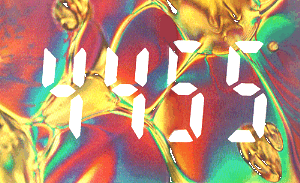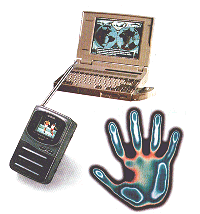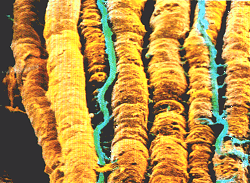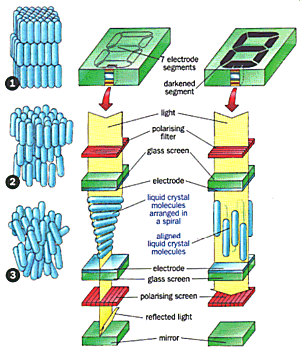
Cold figures from coloured swirls -At the
heart of a liquid crystal display lies an apparently chaotic liquid swirl
that arranges itself in a precise order at the touch of a microcurrent.
Science |
 |
Cold figures from coloured swirls -At the
heart of a liquid crystal display lies an apparently chaotic liquid swirl
that arranges itself in a precise order at the touch of a microcurrent. |
They're neither solid nor liquid nor gas - and they don't look like crystals, either. Yet these materials are crucial to our bodies as well as our electronics. And we're only just beginning to make use of them
We're all familiar with liquid crystals - those black figures silently changing
in watches, or displaying text on a laptop computer. They have become a hallmark
of our digital age.
As their paradoxical name implies, liquid crystals
are Alice - in - Wonderland materials: they
flow in the same way as liquids, yet they affect light like solids. This
bizarre combination of properties is being put to use in some revolutionary
technologies: they are likely to be the key to the new wall-sized television
screens as well as the next generation of CDs, which will allow recording
as well as playback.
Liquid crystals in action |
|
 |
Laptop display - Liquid crystal
computer screens are already close to the quality of ordinary cathode-ray
tubes-in a fraction of the space and without wasting power creating unwanted
heat. Crystal-clear TVs - Improvements to the switching of liquid crystal displays are enabling pocket television sets to become increasingly commonplace. Glowing thermometer - Temperature- sensitive liquid crystal film shows a hand's hot spots - one of scores of medical and scientific applications |
But liquid crystals are now beginning to turn up in some very surprising
places too. Scientists think that liquid crystals may hold the key to certain
medical disorders - including cancer. And most recently liquid crystals have
turned up in a still more unlikely area: cosmology - the study of the origin
and nature of the universe. Researchers in America think that liquid crystals
can help them understand the events that took place billions of years ago,
just after the Big Bang, when galaxies
were being formed.
Liquid crystals are continually springing surprises on scientists even now,
over a century after their discovery. Indeed, their behaviour is so odd that
they were almost not discovered at all. Historians now know that some scientists
actually saw natural liquid crystals under their microscopes as long ago
as the 1850s - but simply wrote them off as curiosities.
These early sightings were made during experiments on a white fatty material
known as myelin, which covers the nerve fibres
in our bodies like the plastic insulation around the filaments in electrical
cables.
A number of scientists noted that myelin turned liquid when left in water.
This liquid was distinctly odd, however: under certain lighting conditions,
it produced spectacular colours - just like light being shone through a
glittering crystal.
| Myelin: the liquid crystal that guards your
nerves Liquid crystals were observed as long ago as the 1850s, during experiments on human nerve fibres, where they were found in myelin - the nerve system's natural insulation system. |
 |
Clearly something strange was going on, but no one probed further. Then another curiosity emerged: these liquids seemed to have two different melting points. Not until the 1880s did the answer become apparent: instead of changing straight into a liquid when heated, these solid materials transform into a kind of intermediate state that emerges at the first melting point, and disappears at the second. Between these two temperatures, the material flows like a liquid yet keeps some of the optical properties of a solid crystal. In short, it has become a "liquid crystal".
Once their existence was confirmed, liquid crystals began to attract many
other scientists around the turn of the century, keen to solve the mystery
of their curious properties. German chemists - then widely regarded as the
best in the world - made the first artificial liquid crystals, and theoretical
physicists set to work on providing theories to explain their behaviour.
|
By the 1920s, it became clear what was happening. Below a certain temperature,
the molecules of liquid crystals are neatly arranged, stacked like cans in
a supermarket display. But heat up a liquid crystal and it starts to show
its peculiarities. In a normal liquid, molecules are randomly arranged; but
the molecules of a warmed liquid crystal retain some of their original
orderliness - just enough order for the liquid crystal to retain the optical
properties of a solid.
Heat a liquid crystal still further, however, and its molecules will eventually
lose their order entirely. Its "solid" properties vanish, and it behaves
as a conventional liquid should.
Scientists discovered that these changes can happen in a number of ways,
giving rise to different types of liquid crystals. In a so-called smectic
type, for example, slight heating jumbles the arrangement of molecules, but
the solid retains a basic, layered structure. In nematic types, by contrast,
the jumbling affects both the individual molecules, and the layers they
originally sat in.
As early as the 1930s, some scientists were talking about putting liquid
crystals to use in a new form of data display, where their optical properties
- and thus what was on the display - would be controlled by temperature changes.
Frustratingly, however, the early liquid crystals were made unstable by small
temperature changes, and their behaviour was too erratic for practical use.
A spectacular solution for cataract sufferers |
||
| People with cataracts - a film that clouds
eye lenses - see more clearly through a small slit: less light in the eye
means less is scattered by the cloudy cataract. Now liquid crystal glasses
have been developed that exploit the effect - but nevertheless allow cataract
sufferers a wide field of vision. The glasses make use of the fact that liquid crystals turn from opaque to clear on application of a weak electric current. They have an array of about 30 tiny liquid crystal panels. When a current is applied to each panel in turn, a narrow horizontal slit appears in the lenses.
|
The breakthrough finally came 40 years later, in the chemistry laboratories
of the University of Hull. Building on the understanding gleaned over decades,
George Gray and his colleagues succeeded in making the first really stable
liquid crystals. Known rather forbiddingly as nematic alkylcyanobiphenyls,
they were cheap as well as stable - and their optical properties could be
precisely controlled using tiny electrical charges instead of heat.
This breakthrough marked the beginning of what has become the multi-billion-pound
international liquid crystal display (LCD) industry. First to appear were
the tiny voltage-controlled LCDs in watches and calculators, which simply
showed figures and letters in black against a paler background. Unlike the
light-emitting diodes they replaced, they used minute quantities of electric
current. By the late 1980s, however, tiny colour televisions started to appear,
based on differently oriented liquid crystals. Many computer displays now
use them, and it is only a matter of time before really large colour LCD
"flat televisions" reach our homes - far larger than could be made using
conventional cathode-ray tubes, and far less power-hungry.
But these technological applications have masked the much wider importance
of liquid crystals. Some of these hark back to the very early days, when
it was the biologists rather than the physicists who were trying to understand
their properties.
Every living organism on earth is made up of cells - squidgy bags of fat
so small that 10,000 of them would barely cover the head of a pin. Life itself
is sustained by these cells interacting with each other - taking in nutrient,
putting out proteins. Yet, paradoxically, these same delicate cells make
up the bodies of even the largest, toughest creatures. There is one type
of material perfectly suited to both that can provide the strength and
flexibility required by a living cell: liquid crystal.
Scientists now know the walls of living cells consist of liquid crystal materials
called phospholipids. A dramatic illustration of this is provided by bacteria
that grow deep in the ocean under tonnes of pressure per square metre. The
phospholipids at this pressure retain enough liquid crystal structure at
the ambient temperature to provide a strong cell membrane capable of withstanding
the strain.But when the bacterium is brought to the surface, the pressure
drop changes the critical temperature at which the liquid crystal cell walls
can maintain their structure. They become completely liquid: the bacterium
disintegrates, and dies.
Scientists have discovered that living organisms have learnt to control the
liquid crystal properties of their cells precisely, so that the critical
pure liquid temperature is always above the temperature of their environment
- but only just. For the cell walls must not only be strong enough to protect
the contents, they must also stay permeable enough for the processes of life
to continue.
Changing states: how a digital display works |
|
 |
A simple black - or - white LCD display works
by either allowing daylight to be reflected back out at the viewer or preventing
it from doing so - in which case the viewer sees a black area. The liquid
crystal is the part of the system that either prevents light from passing
through it or not. The crystal is placed between two polarising filters that are at right angles to each other and together block light. When there is no electric current applied to the crystal, it twists light by 90o, which allows the light to pass through the second polariser and be reflected back. But when the voltage is applied, the crystal molecules align themselves, and light cannot pass through the polariser: the segment turns black. Selective application of voltage to electrode segments creates the digits we see. |
| If you heat a liquid crystal... A cool liquid crystal is solid (1) . A temperature rise melts it into a unique semi-liquid state (2) . Further heating makes it fully liquid (3) . | |
Humans rely on the properties of natural liquid crystals for their well-being
too. The breakdown of myelin, the substance wrapped around nerves, can have
serious effects on the nervous system - including multiple sclerosis.
Although the precise cause of the breakdown is still mysterious, it is thought
to be tied to the liquid crystal properties of myelin, on which its insulating
qualities depend. A failure of the liquid crystal structure of the myelin
causes an insulation failure, which devastates the transmission of nerve
impulses. Sickle-cell anaemia - the blood disorder in which the red blood
cells take on a peculiar shape and fail to perform adequately - is another
example of the importance of liquid crystals. Because of a genetic defect,
sufferers of this disease carry in their blood cells abnormal haemoglobin
molecules with unwanted liquid crystal properties. These molecules give the
blood cells a stickiness that dramatically reduces their efficiency as oxygen
carriers, and leaves sufferers weak and feverish.
It is possible that natural liquid crystals could even play a role in cancer.
Cancer - essentially the uncontrolled growth
of cells - is notorious for starting in, say, the liver and spreading
("metastasising") to other organs.
Ordinary, healthy cells have arrangements of so-called
microtubules around them. Like the regular
pattern of molecules in a liquid crystal, this seems to provide a relatively
rigid structure that appears to control the movement of cells. In cancerous
cells, however, these microtubules are less ordered - and are thus less well
able to stop the cells spreading to other parts of the body. Understanding
why the microtubules have these liquid crystal properties, and why they lose
them, will surely prove useful in the war against cancer.
Recently scientists have come up with perhaps the most surprising role yet
for liquid crystals: as models for events that took place at the beginning
of the universe.
Researchers trying to understand what happened billions of years ago, just
after the Big Bang, face an apparently insuperable problem: they cannot go
back in time to test their ideas in the original conditions. But this year,
American scientists showed that liquid crystals may help cosmologists get
around this problem.
Re-running the Big Bang in liquid crystal
simulation
|
|
| (1) Bubbles appear after heating of the "mini-universe". (2) The bubbles start to merge, forming bigger structures. (3) Regions between bubbles become sharply defined. (4) These regions join up as "string defects". (5) Counting the remaining defects gives a test of cosmic theory. |
According to current theories, the very early universe was incredibly hot
and dense, and in an utterly different state from today. But as it expanded
and cooled, the universe started to undergo radical changes: so-called "phase
changes", rather like water turning into solid ice.
These changes did not occur uniformly, however: different parts of the universe
"froze" at different rates and into different states, like the patchwork
of frost on an icy windowpane. Where these contrasting regions meet, so-called
defects form.
Cosmologists have tried to calculate how many such defects are generated
around each region of the universe. They are keen to find out, because too
many defects could lead to a universe quite unlike the one we know today
- suggesting that current theories of the early universe could be completely
mistaken.
Dr Mark Bowick and his colleagues at the universities of Syracuse and Santa
Barbara realised that as they cool down, liquid crystals undergo very similar
"phase changes" to the universe itself. So could liquid crystals point the
way to our cosmic past?
To find out, the team heated up a nematic crystal, and watched what happened
as it cooled. Under their microscope, they saw little regions of liquid crystal
form and start to merge, just like parts of the early universe cooling down
and "freezing" into various states. After about ten seconds, defects between
the liquid crystal regions were clearly visible too. This was all in perfect
agreement with existing theories of the early universe.
Liquid crystal polymers - the new plastics |
|||
|
|
|
|
|
Material that won't wear out In yet another manifestation of liquid crystals, Kevlar, manufactured by Du Pont, is used wherever great abrasion- resistance is required - such as in yacht-sails |
Armour that resists a speeding bullet The ability of liquid crystals to withstand extreme pressures means that Kevlar is also one of the most commonly used materials for bullet proof vests |
|
But the experiment did more than confirm the broad ideas. Counting the number
of these defects, Dr Bowick and his colleagues compared what they saw with
the predicted number from the theory used by cosmologists. It turned out
that the number of defects they saw for each separate region also corresponded
perfectly with theory.
Cosmologists, it seems, really might have a good understanding of the early
universe after all. And who would have thought that those little black numbers
silently changing in your watch or CD player could cast light on the mysteries
of the cosmos?
Robert
Matthews
![]() Nov 1994
Nov 1994